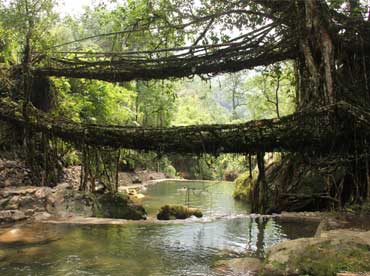The Living Root Bridges are incredible feats of engineering built by the indigenous people of Meghalaya, a state located in the North East India. These bridges are builtusing the living roots of ficus trees (Ficus elastica) planted on both sides of a stream and then made to span the width of the river until they meet at the middle. These bridges are built by the Khasi and Jaintia tribes that live in the state and can be found mostly along the southern edges of Meghalaya including the villages of Nohwet (Riwai, Mawlynnong), Nongriat, Nongthymmai, Mawkyrnot, Nongblai, Khonglah, Padu, Kudeng Rim, Shnongpdeng and others.
An interesting highlight about the people of Meghalaya is that they follow a matrilineal system i.e. lineage is passed down through the mother. The culture of the people of Meghalaya is also deeply intertwined with nature. People rely on nature for their daily needs and because of this, conservation of nature is crucial to them. The Khasi and Jaintia people who reside in the southern parts of the state along the international border with Bangladesh are called the "War" people. Their main occupation is agriculture. The War villages are nestled on the hill-sides while their agricultural lands are located in the valleys below.Most of their villages are only accessible by traversing huge cliffs, valleys, waterfalls, streams and rivers.
In the past, during monsoons, it was difficult for people to cross the many waterways without bridges.Attempts to use bamboo or wooden bridges across these waterways proved futile as these bridges could not last long in the heavy rains and strong waters. Living root bridges are an innovative and indigenous solution to solve thisage old problem.
The bridges are constructed by plantingficus trees on both sides of the waterways.Hollowed out a betel nut (Areca catechu) trunk are used to propagate the aerial roots from one side of the river to the other. When they reach the other side, they’re allowed to take root into the soil. The roots are woven and nurtured until they mature and are able to bear the weight of people walking on them. This entire process can take 15 to 25 years to complete and the bridges formed can last for hundredsof years.Some bridges are as long as 100 feet and can take loads of more than 50 people.







